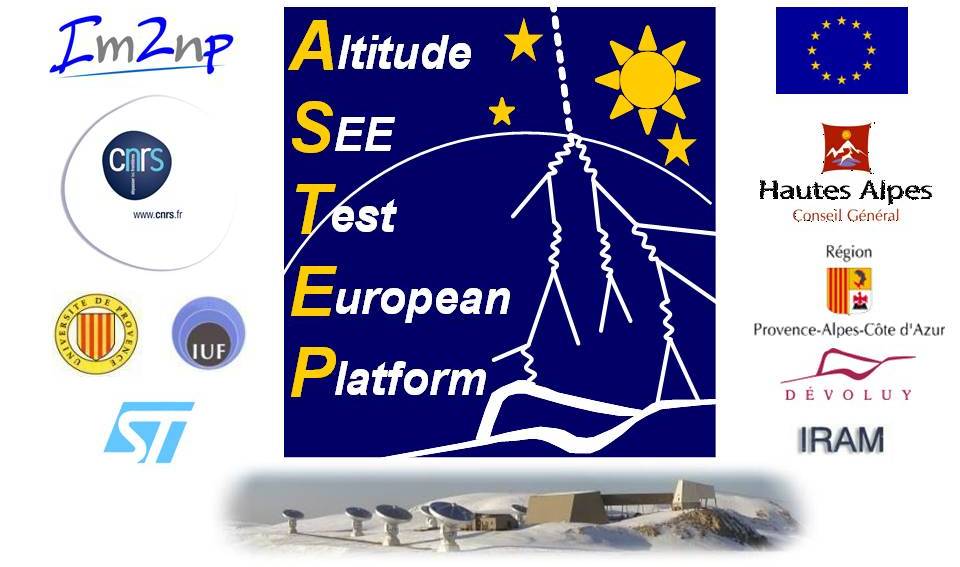Plateau de Bure, France
The Plateau de Bure NM station is operated by IM2NP-CNRS, a French academic laboratory of Aix-Marseille University (Marseille, France). The NM instrument is housed in a specially constructed room at the roof of the POM2 Building, a small building of the Institute of Radio-Astronomy at Millimeter wavelengths (IRAM), located on the desertic Plateau de Bure (Devoluy Mountains, French South Alps).
Specifications
| Detector | 3-NM64 neutron monitor |
| Geographic latitude | 44° 38’ 02”; N |
| Geographic longitude | 5° 54’ 26” |
| Altitude | 2555 m asl |
| Effective vertical cutoff rigidity (Epoch 2000.0) | 5.0 GV |
| In operation: | July23, 2008 |
Detailed station information:
The Plateau de Bure NM is a scientific instrument of the ASTEP Platform (Altitude Single-event effects Test European Platform), a permanent installation dedicated to the study of the impact of terrestrial natural radiation on microelectronics circuit reliability. The construction of this instrument was initially decided to survey on site and in real-time (typically minute per minute) the time variations of the natural atmospheric neutron flux incident on the microelectronics experiments deployed on the ASTEP platform. The integration of the instrument was finalized in June 2007; its installation on site was performed in July 2008 after quasi one year of operation and test at IM2NP-CNRS in Marseille.
1-hour data (Excel file format) and additional material (photos, publications) are available from the website of the ASTEP Platform.
The Plateau de Bure NM is very similar to a standard “3-NM64 neutron monitor”. The ensemble detector is based on three high pressure (2280 Torr) cylindrical 3He detectors, model LND 253109, surrounded by a 25mm coaxial polyethylene tube and by 20 coaxial thick (50mm) lead rings. All these elements are placed inside a 80mm thick polyethylene box. The only geometrical difference between a standard 3-NM64 design and this instrument concerns the exact geometrical shape of the lead rings (rings without lateral extensions, i.e without “ears”, but with a flat bottom size) which are directly stacked on the bottom of the polyethylene box. A Canberra electronic detection chain, composed of three charge amplifiers model ACHNP97 and a high voltage source 3200D, was chosen in complement to a Keithley KUSB3116 acquisition module for interfacing the neutron monitor with the control PC. A dedicated software under Visual Basic 2008 was developed to control the PdBNM data acquisition as well as to manage and time stamp data using a GPS time acquisition card installed on the same PC.

References
S. Semikh, S. Serre, J.L. Autran, D. Munteanu, S. Sauze, E. Yakushev, S. Rozov, “The Plateau de Bure Neutron Monitor: design, operation and Monte-Carlo simulation”, Submitted to IEEE Transaction on Nuclear Science, preprint available on ArXiv: http://arxiv.org/abs/1104.4700
J.L. Autran, D. Munteanu, P. Roche, G. Gasiot, S. Martinie, S. Uznanski, S. Sauze, S. Semikh, E. Yakushev, S. Rozov, P. Loaiza, G. Warot, M. Zampaolo, “Soft-errors induced by terrestrial neutrons and natural alpha-particle emitters in advanced memory circuits at ground level”, Microelectronics Reliability, 2010, Vol. 50, p. 1822-1831. http://dx.doi.org/10.1016/j.microrel.2010.07.033
J.L. Autran, G. Gasiot, D. Munteanu, P. Roche, S. Sauze, “Real-Time Soft-Error Rate Characterization of Advanced SRAMs” in “Radiation Effects in Semiconductors, Edited by K. Iniewski (CRC Press, August 2010), p. 225-247. http://www.crcnetbase.com/doi/pdf/10.1201/9781439826959-12
J.L. Autran, P. Roche, S. Sauze, G. Gasiot, D. Munteanu, P. Loaiza, M. Zampaolo, J. Borel, “Altitude and Underground Real-Time SER Characterization of CMOS 65nm SRAM”, IEEE Transactions on Nuclear Science, Vol. 56, 2009, Vol. 56, N°4, p. 2258-2266. http://dx.doi.org/10.1109/TNS.2009.2012426